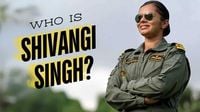The Press Information Bureau (PIB) has categorically denied viral claims that Indian Air Force pilot Squadron Leader Shivangi Singh has been captured in Pakistan. "Indian Female Air Force pilot has NOT been captured," PIB Fact Check stated on social media, clarifying that false information was being circulated by pro-Pakistan accounts. The rumour, which gained momentum across various platforms amid ongoing military tensions between India and Pakistan, falsely alleged that Singh had been arrested near Sialkot after her fighter jet was downed. Some posts even included an unrelated video attempting to depict her capture. "This claim is fake," PIB asserted, calling it a deliberate piece of disinformation spread to manipulate public perception during the India-Pakistan conflict. The agency urged citizens to remain cautious about viral content and to verify such claims before sharing.
The India vs Pakistan war climate has led to a surge in fabricated narratives online. Several Pakistani propaganda handles have been pushing doctored visuals and baseless stories aimed at sowing confusion and panic. The claim about Shivangi Singh’s capture was among the most prominent, using her name and image to falsely imply a military setback for India. However, officials have confirmed that no such incident occurred, and the pilot is safe.
Squadron Leader Shivangi Singh is a trailblazing figure in the Indian Air Force, known as the country’s first woman Rafale pilot. Born in Varanasi, Uttar Pradesh, she was inspired to join the Air Force after visiting the Air Force Museum in New Delhi as a child. Commissioned into the IAF in 2017, Singh initially flew the MiG-21 Bison before transitioning to the Rafale fleet. She has also represented India in key international military drills, including the Orion exercise in France.
At just 29, Shivangi Singh has made history as India’s first and only woman pilot flying the powerful French-made Rafale fighter jet. Her fascination with flying began nearly 20 years ago when she visited the Air Force Museum in New Delhi. Standing under the shadow of aircraft for the first time, she recalls being completely mesmerized. "I immediately knew that I wanted to become a pilot," Singh told AFP during a recent visit to the same museum.
What started as childhood awe has turned into a remarkable journey that has broken barriers in India’s military history. When women were allowed to join the Indian Air Force (IAF) as fighter pilots in 2015, Singh was among the early few to step forward. Her courage and determination led her to fly the formidable single-seat Rafale, becoming the first Indian woman to do so. Now a lieutenant, Singh has become a symbol of change and progress in the armed forces. "There have been many of us. This not only reflects modernization but also the fact that we can now realize our dreams," she said.
Singh’s personal life also reflects her passion for aviation—she is married to a fellow fighter pilot. Together, they represent a new generation of IAF officers driven by skill, courage, and equality. Having already made her mark in the sky, Singh now has her sights set on space. Her aspiration to become an astronaut signals a new chapter—not just in her personal journey but also in the growing role of women in India’s defence and aerospace sectors.
Shivangi Singh’s story is not just about flying a jet—it’s about shattering ceilings, both literal and symbolic. From a starry-eyed child at a museum to commanding a Rafale and aiming for the stars, she stands as a role model for millions of young Indians, especially girls dreaming of a future in aviation or space.
On April 22, 2025, a devastating terror attack in Pahalgam, Jammu and Kashmir, claimed the lives of 25 Indian civilians and one Nepali national, marking it as the deadliest assault in the region in 25 years. The attack, attributed to Pakistan-based terror groups like Lashkar-e-Taiba and Jaish-e-Mohammed, prompted India to launch Operation Sindoor on May 7, 2025, targeting nine terror camps in Pakistan and Pakistan-occupied Kashmir with Rafale jets armed with SCALP missiles and HAMMER bombs.
As tensions escalated, India resorted to defensive strikes to counter Pakistan’s retaliatory actions, including drone incursions and shelling along the Line of Control. Squadron Leader Shivangi Singh is set to play a pivotal role in these operations, flying the advanced French-made Rafale jets. Her involvement underscores India’s modernising air force and the growing role of women in combat roles.
Singh was inspired to pursue aviation after a childhood visit to the Air Force Museum in New Delhi. She completed her schooling in Varanasi and earned a Bachelor’s degree from Banaras Hindu University (BHU). Demonstrating academic excellence and a passion for aviation, she joined the Indian Air Force Academy (AFA) in Hyderabad for rigorous training, a critical step toward becoming a fighter pilot.
To qualify as a Rafale pilot, Singh underwent a stringent selection process. Commissioned into the Indian Air Force (IAF) in 2017 as part of the second batch of women fighter pilots, she initially trained on the MiG-21 Bison, mastering the skills required to handle high-performance aircraft. In 2020, after excelling in a competitive evaluation, she was selected for Rafale training, which included advanced simulator sessions with French instructors.
Her training focused on the Rafale’s sophisticated systems, including its Thales RBE2 AESA radar and precision weaponry, equipping her for complex missions like those in Operation Sindoor. Singh’s educational foundation and relentless determination enabled her to break gender barriers in a field long dominated by men. As part of the IAF’s Golden Arrows squadron in Ambala, she has represented India in international exercises like Orion in France.
With over 1,600 women officers in the IAF as of 2023, Singh’s achievements highlight the modernisation of India’s armed forces and inspire future generations. Her participation in the Indian Air Force tableau during the Republic Day parade is a symbol of modernization and progressive induction of women in combat air roles.
As tensions between India and Pakistan continue to simmer, misinformation and propaganda surrounding military events are rampant. The PIB's swift denial of the false claims regarding Singh’s capture reflects a broader need for vigilance and verification in the age of social media. Singh’s story, alongside her pivotal role in current military operations, emphasizes not only her personal triumphs but also the ongoing evolution of women’s roles in the Indian military.





